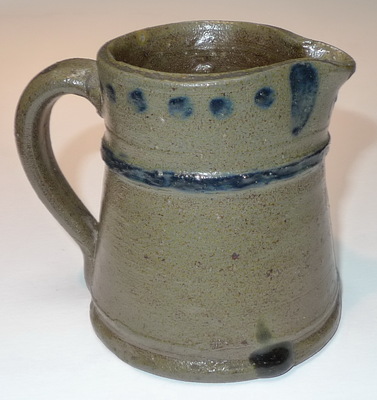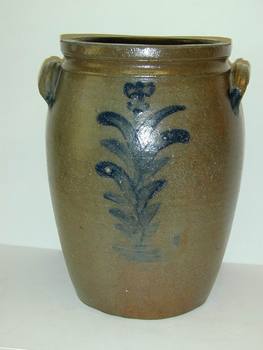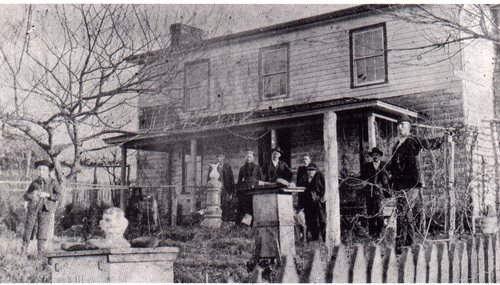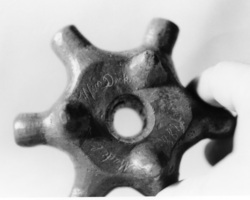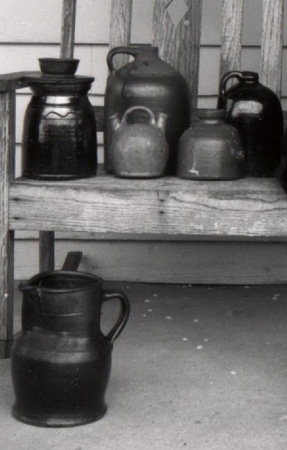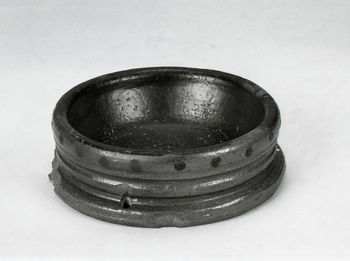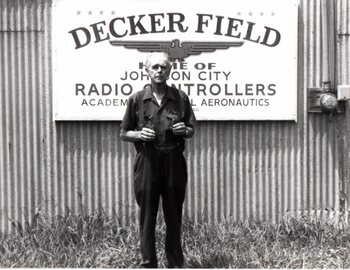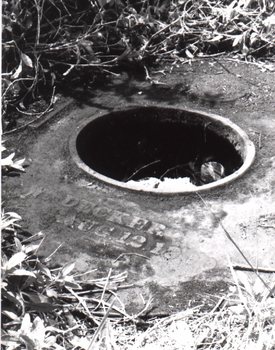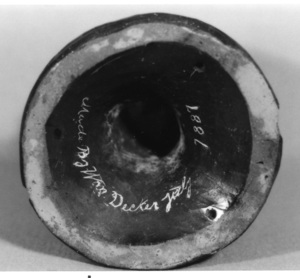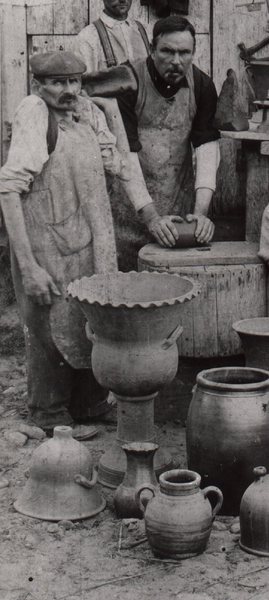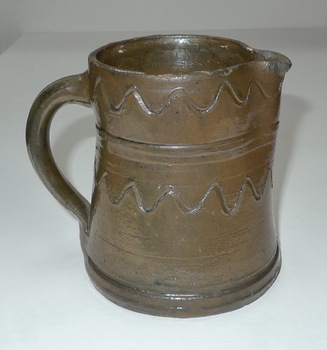William Decker
“UNCLE BILLY”
February 3, 1859 – October 27, 1909
POTTER COBBLER HORTICULTURIST
PHYSICIAN VETERINARIAN POSTMASTER
If time travel were possible and I could go back to the turn of the century for a visit with one — but only one — of the Deckers, the choice would probably be Uncle Billy. As the picture on the preceding page shows, he was physically deformed as the result of a fall from his highchair suffered in infancy. The rather cruel term used in his day was “hunchback”. His appearance and short stature may well explain why he never married but he did not allow his misshapen body to prevent him from becoming an excellent potter. If some discerning young woman in the valley had looked beyond his pathetic deformity she would have seen a man with uncommon intellect, keen imagination and much ability. Not only was he a creative potter but a skilled horticulturist, a competent cobbler and a good businessman as well. He also practiced medicine though he had no formal training and, on occasion, filled in for his brother Charles as a veterinarian. The Tennessee State Gazeteer for 1891 lists him as Postmaster for the Chucky Valley post office which was near the pottery.
While his other skills added to his earnings and provided a change from the routine of pottery making, it was his work at the potter’s wheel which produced the pieces which cause him to be remembered. The novel and varied creations which have survived not only attest to his imagination and skill but show clearly that pottery was his chief means of self-expression. His pride in his craft led him to sign and date numerous pieces and it is not surprising that more examples have been found with his signature than there are by either his father or his older brother, Charles Jr.
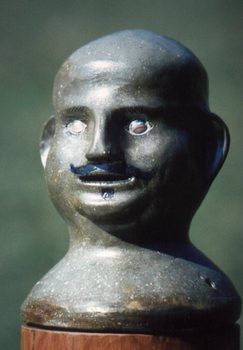
Gatepost ornament with cobalt decoration and marbles for eyes. It is incised Made By Wm Decker July 1887 inside the base. illus15.
July 1887 found him engaged in producing a rather dramatic piece for display in the Decker house or front yard. The almost life-sized effigy of a man’s head shown in illustration 15 is of gray stoneware decorated with a cobalt blue Prussian style mustache and goatee. The use of multicolored blown glass marbles for eyes adds a touch of humorous whimsy which is hardly in keeping with Uncle Billy’s own stern appearance. Perhaps this confirms family tradition which says that he had a keen sense of humor. The head is very heavy, is nine and one-half inches high, has a base diameter of seven inches, and is inscribed “Wm. Decker” inside the base. It was obviously designed for use on a gatepost in the front yard or upon the newel post of the stairway in the Decker front hall. Three holes were punched through the soft clay at the time it was molded so that it could be screwed or nailed in place. However, Uncle Billy may have been disappointed for his creation seems not to have been given a place of prominence at either location. Instead, it was relegated to the floor and served as a doorstop for some time and later appears in a picture which shows the head as a weight on the lid of a beehive, along with a rock or two. (See illustration 16, left foreground.) Editors note: Beverly was mistaken. The head on the beehive is a different head entirely. This hardly seems fair since the same photograph shows the very large yard ornament made by his father three years earlier standing by the front step and just in front of its maker. Perhaps his feelings were soothed by the fact that the very handsome yard ornament made by his older brother Charles in 1885 is nowhere to be seen.
The following year he produced a pipe which is novel and perhaps unique in American pottery. Of course single “smoke pipes” were a standard production item with many potteries, including the Decker’s. Uncle Billy’s creation has six small bowls arranged in a circle, each with a short stem into which a reed from cane along the river could be inserted. The pipe sits upon three small feet. (See illustration 17.) The base is scratch signed "Made by Wm. Decker, Jan. 1888. " In theory, at least, six persons seated in a small circle and using long reeds could have smoked the pipe simultaneously. However, close examination does not reveal any caking of tobacco inside the bowls nor is there any discoloration on the outside which might be expected after much use. It may be that he never intended for the pipe to be used and that it represents nothing more than an expression of his desire to create something different and distinctive.
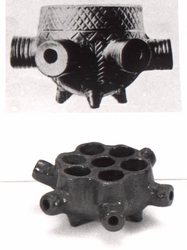
Uncle Billy’s pipe signed Made by Wm Decker Jan 1888 with an image of a Catawba Indian pipe above it. illus18.
The question remains whether the pipe was purely his own creation or whether it might have been inspired by something which he had seen or of which he had heard. One interesting possibility made plausible by the curiosity which he probably had about the native American Indians is that he might have seen a basically similar pipe made by the Catawba Indians. For hundreds of years the Catawbas had lived along the Wateree River near the North and South Carolina border. A look at a map shows that the trade route from Charleston across the mountains into upper East Tennessee which had been in use since before the American Revolution passed through Catawba country. Dick Polhemus, archaeologist and authority on the Indians of the Southeast, tells me that at least by 1875 the Catawbas were making pottery pipes very similar to the one made by Uncle Billy Decker and were selling them to curious white passers-by as souvenirs. It is certainly possible that some traveler might have carried one into the Decker area and that Uncle Billy took his inspiration from it. Illustration 18 shows a line drawing of a Catawba multi-stemmed pipe above Uncle Billy’s. This possibility is not mentioned to detract in any way from Billy Decker’s talent or imagination but the chance that this son of a German immigrant might have been influenced by a centuries old design of an American Indian is too intriguing to ignore.
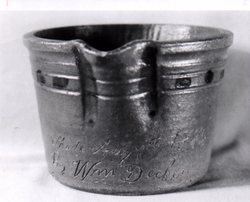
Cobalt decorated bowl with spout. Incised under the spout Made Aug 9th 1884 By Wm Decker. Seen in the Tennessee Conservationist. illus19.
Uncle Billy’s affection for members of his family found expression in making special pieces for them. Some are in forms which were produced in quantity for sale to the public such as milk pans. The commercial products would have borne little or no decoration and would not have been signed. When we find one in possession of a descendant which is decorated in cobalt blue and carries Billy’s name plus the date (1886) and place where it was made, we must assume it was made for his stepmother or a sister-in-law. (See illustrations 19 and 20siBB.) That it was made as a gift is further borne out by the fact that it is much smaller than those made for sale, being only five inches high and seven inches across the top. It would hold little or no more than a quart of milk while those made for sale usually held a gallon or more. Since the chief purpose of such vessels was to allow the cream to rise and to be poured off with the aid of a lip in the rim, the one illustrated would have had limited practical use. A friend suggested facetiously that perhaps the recipient had but one small cow. In any case, the gift must have been appreciated since the piece remains in perfect condition.
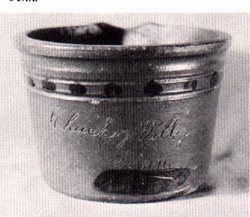
The reverse of the cobalt decorated bowl with spout. Incised Chucky Valley Tenn. Seen in the Tennessee Conservationist. illus20siBB.
Another “presentation piece” is the beautifully formed and colored, double-spouted little jug which he made for some family favorite in 1896. (See illustration 21na.) Editors note: see Illus. 12siBBc cropped from the image of Lutora sitting on the porch. The recipient may well have been his sister-in-law, Hester, wife of his half-brother, Dick, since it was in the possession of their daughter, Lutora Decker Barnes. This piece would have had even less utility than the milk pan just described since it is only five and one-half inches high and is but four inches in diameter. At most it would have held a generous cup of coffee but like the milk pan, it shows no signs of use. It may well be that the family members who received such tokens from Uncle Billy held him in such esteem that the pieces immediately found their way to a shelf or cupboard for display and preservation. Whatever their reasons may have been we can be grateful that such pieces were kept for us to appreciate and enjoy.
Unlike the two preceding items, a mortar turned by Billy in 1897 saw a great deal of use. (See illustration 22na.) Whether made for his older brother, Charles, a part-time physician and druggist, for use in grinding ingredients for prescriptions, or for his stepmother, Susan, for use in mixing herbs for food seasoning, we can only speculate. It may also be that he made this object for his own use since the account books of the family show that Billy also provided medical services, possibly at times when his brother, Charles, was not available. There is no documentary proof that he personally prepared medicine for his patients but when we recall that no license was necessary he may well have mixed “cures” at will. Several large chips off the base suggest hard treatment. The base contains the following inscription: Dec 4th 1897 Made by Wm. Decker At the key-stone pottery of Chucky Valley Washington Co. Tenn. (See illustration 23.)
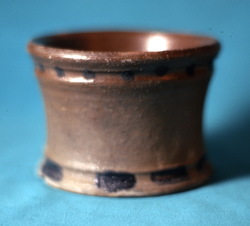
Small cobalt decorated mortar incised on the base Made Dec 4th 1897 By Wm Decker At the Keystone Pottery of Chucky Valley Washington Co Tenn. illus23.
Since another mortar — also well used — was found in the Charles Decker, Sr. home, let’s assume that it was used by Dr. Charles and that caution kept Uncle Billy from compounding remedies on his own. This would leave use to stepmother Susan who was certainly entitled to this and all other kitchen aids she could get. Beside her own family she had itinerant potters to feed and, on occasion, farm hands as well. We need only recall that all three of Decker’s wives preceded him in death in order to conclude that life was not easy. Incidentally, the “other mortar” referred to above is dated but not signed. It is privately owned. (See illustration 24na.)
The final object illustrated which was signed by Uncle Billy reflects a different kind of affection — that of man for his dog. Illustration 25si depicts a nicely made dog dish ornamented with cobalt blue dots around the rim. The base is inscribed “Made by Wm Decker Nov 1st 1906,” (See illustration 26na.) Family members recall that in the last few years of his life Uncle Billy had his dog “Shep” as his constant and faithful companion. This is reinforced by the fact that upon close inspection three group photographs made during that period show Uncle Billy with Shep at his side. If made for sale no decoration would have been called for and certainly no signature by the maker. Add the fact that none of the records of wares produced at the pottery mentions the making of a dog dish and we can surely conclude that Uncle Billy made it for his pet, Shep. Two and five-eighths inches high and eight and three-quarter inches in diameter, the dish also reflects the inbred German trait of practicality in that it has three holes around the bottom rim so that it could be nailed to the floor of the back porch of the Decker home.
The story of the dog dish ends on a sad and poignant note. A surviving family member recalls that when her Uncle Billy died some three years after making the dish for Shep, the dog was disconsolate. Knowing that something was terribly wrong, Shep followed the wagon bearing Billy’s body to the undertaker until stopped and returned to the house by family members. When the body was returned to the house and taken inside the dog stood at the door and howled until Grandpa Decker told a family member to let him come inside. Thereafter, he lay on the floor beneath the casket with only an occasional whimper to indicate his presence. On the day of burial he followed the family across the river to Mount Lebanon Cemetery and refused to leave the grave until carried to a wagon for the sad trip home. The following morning Shep was not in his usual bed in a corner of the porch. Suspecting that the dog had returned to the cemetery, a family member saddled his horse and rode back across the river to the graveyard. To his surprise, Shep was not there and he was never seen again.
As was true with his older brother Charles, Billy’s story does not end with the pottery which he produced. While there is no record of his receiving any education beyond public school in Philadelphia, he developed skills in farming and horticulture which came to be recognized throughout Washington County. Although but twelve or thirteen when his family settled in the Chucky Valley, Billy showed an early interest in farming, particularly in the growing of fruit. Apple, peach and pear trees were planted on the slope east of the Decker home and more were set out to the rear of the house. By some means Billy learned the art of grafting fruit trees so that one tree could be made to ber more than one variety. Billy’s namesake and nephew, Bill, remembers that as a boy he and other family members picked five different kinds of apples from one tree. The knife-like instrument which Uncle Billy used in grafting is one he made for himself from available materials, one of which was a piece of a steel file. Bill Decker keeps it in his store and would be pleased to show it to you if you have a “green thumb.”
Perhaps it was Billy Decker’s skill in grafting fruit trees which caused his name to spread in farming circles. It might also have been as a result of some innovation in farming the level bottoms below the house. Whatever the reason may have been, he became a leader in the Washington County farm community and in 1906 he was appointed by State Agriculture Commissioner W.W. 0gilvie as a delegate to the Farmer’s Institute in Knoxville. Bill Decker has preserved his uncle’s Certificate of Appointment which also shows that Uncle Billy received courtesy transportation to and from the meeting from the railroads serving East Tennessee.
Illustration 27 shows Bill Decker holding an object in each of his hands. In one is the grafting instrument mentioned earlier and in the other he holds a tool of another of his Uncle Billy’s trades — a leather punch from his set of cobbler’s tools. Jonesboro, the nearest town, was miles away with its stores and shoemakers. The pottery, the store and the post office all brought the people of the valley to the Decker’s property. Shoes and boots needed repair and, at times, special shoes needed to be made. The opportunity for additional income was not lost on Billy and the account books found in the Decker houses contain many entries showing the names of persons for whom he repaired boots and shoes and the charges made for his services.
Typical entries from an 1889 ledger include these charges:| to James Turner for 1/2 "soleing" boot | 10 cents |
| to Alex Johnson for fixing his boots | 5 cents |
| to his brother, Fred for fixing boots | 50 cents |
| to N. Orton for making slippers | 50 cents |
| to his brother, Charles, for fixing shoes | 40 cents |
While such charges may cause us to smile today we should recall that a full century has passed and that when Billy made these charges his father was paying 25 cents to 75 cents per day for helpers to dig clay, cut and haul wood, and work on the Decker farm. Remember too that a “day” was sunrise to sunset.
The step from fixing boots and shoes to the practice of medicine may seem to be a long one but it was no problem for Uncle Billy. There is no record of his having studied with any practicing physician in the county and it is certain that he had no formal education in medicine. He may have spent some time with some doctor in the area but it is probable that he “studied” under his older brother, Charles. It was certainly “on the job training” and such a thing would be both unheard of and illegal today. We must remember that standards for the training of physicians were in their formative stage and that it was not until _____ that a state license was required to practice in Tennessee. Unlike his older brother, he does not appear to have taken the title of “Doctor” but the family ledgers and account books contain many references to house calls made by both Dr. Charles and William. 75 cents was the usual charge with any medicine prescribed added to the bill. Some typical entries in a journal used in 1889 include:
| to N. Orton 1 trip by William for medical aid | 75 cents |
| medicine for Boss and Carrie | 75 cents |
| to N. Orton 1 trip by William medical aid | 75 cents |
| turpentine | 05 cents |
| medicine prescribed | 15 cents |
| to David Johnson medicine for throte | |
| by William | 10 cents |
| to Jacob Ray by William's medicine | 05 cents |
| to George Brown medical aid by | |
| William and self (This was one of several instances in which both doctors answered a call.) | 1.50 cents |
| to John Kyker for medical aid on | |
| call to house | 75 cents |
| bottle of medicine | 50 cents |
Uncle Billy also served as Postmaster to the Chucky Valley Post Office which was in a small frame building beside the pottery. Twice a week a packet of mail arrived from Jonesboro and for the next few days people in the Valley who were expecting mail would stop by. The pay was undoubtedly small but the job could not have required a great deal of time and it brought people to the pottery. It may also have meant more trade for the Decker General Store which was on the road along the river.
It may come as no surprise that William Decker, like his brother Charles, also practiced veterinary medicine on the Valley’s sick animals. He had also learned blacksmithing and kept the Decker horses shod. If he saw a need he would find a way to fill it. The cistern beside his father’s house needed a new cover — a sturdy one which would stay in place and would bear the weight of a person drawing water. William set about making a mold which could be taken to one of the area iron foundries where a casting could be poured. The result was a heavy circular iron cover which is still in place today. Here again there was money to be made and several others were made for sale to neighbors in the valley. Each carries the name Wm. Decker in bold letters along with the date Aug. 12, 1900 (See illustration 28). Chalk was applied to both letters and figures before the picture was taken.
History is filled with examples of persons who overcame severe physical disabilities and achieved success in their chosen fields. We can add the name of potter William Decker — certainly an uncommon man in a commonplace setting.
Editor’s note: only a small number of photographs accompanied the essays. An effort will be made to obtain the missing images for this site. For the present, poor quality images were deemed better than no images. An na indicates that no image was available. An si indicates that it is a substituted image. If the source of the substituted image was Beverly Burbage a BB will be affixed. An ai indicates that it is an added image. If the original source of an added image was Beverly Burbage then Burbage will be added to the image caption.
Copyright 2009-2022, Carole Wahler
Site by GearheadForHire, LLC | v1.0.2
